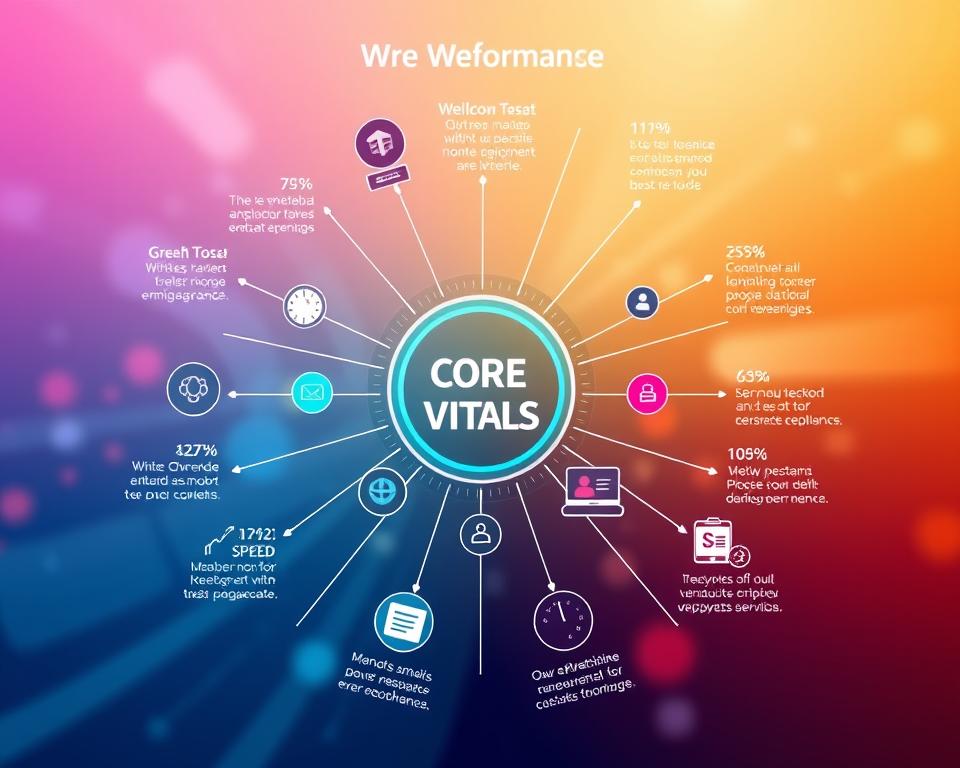SEO is always changing, and keeping up is key for a strong online presence. As we get closer to 2025, Google’s search algorithm will see big changes. Website owners need to update their strategies to succeed in this new world.
This guide will cover the main updates, ranking factors, and advanced techniques. It will help you get your website ready for Google’s latest algorithm in 2025.
Table of Contents
Key Takeaways
- Understand the core updates to Google’s 2025 algorithm and their impact on website rankings.
- Implement essential technical SEO requirements to meet the new standards.
- Optimize for mobile-first indexing and provide an exceptional user experience.
- Leverage AI and machine learning tools to enhance your SEO strategy.
- Ensure your website aligns with the latest content quality signals and E-E-A-T principles.
Understanding Google’s 2025 Algorithm Core Updates
Google’s search algorithm is changing to meet user needs better. The 2025 update will change how websites rank and look on search engine results pages (SERPs).
Key Changes in the Latest Algorithm Release
The 2025 update will focus more on content quality and user experience (UX). It will also emphasize mobile optimization. Key changes include:
- More emphasis on E-E-A-T (Expertise, Experience, Authoritativeness, and Trustworthiness) signals
- Using advanced natural language processing (NLP) to understand user intent better
- Core Web Vitals and technical performance metrics will count more
- Penalties for thin, low-quality content will be stricter
Impact on Website Rankings
The 2025 update will change how websites rank in search results. Websites not adapting to these changes may see less visibility and traffic.
Major Ranking Factors in 2025
| Ranking Factor | Importance |
|---|---|
| Content Quality and Relevance | High |
| User Experience (UX) and Core Web Vitals | High |
| E-E-A-T Signals | High |
| Mobile Optimization | High |
| Technical SEO Factors | Moderate |
| Link Building and Authority | Moderate |
Understanding these changes can help businesses keep up with Google’s search landscape. They can adjust their SEO strategies to stay competitive online.
Essential Technical SEO Requirements for 2025
The digital world is always changing, making technical SEO more important than ever. In 2025, it’s crucial for websites to focus on key technical areas. This ensures they meet Google’s latest search standards.
Site Speed Optimization
Site speed will be a big deal in 2025. Your website needs to load fast, no matter the device or connection. To achieve this, you can optimize images, use browser caching, and set up a content delivery network (CDN).
Improved Crawlability and Indexing
Enhancing your website’s crawlability and indexing is also vital. Make sure your site’s internal links are good, create a detailed XML sitemap, and check your robots.txt file. This helps search engines find and index your content easily.
Secure Connections and HTTPS
With online security on the rise, HTTPS is now a must for good Google rankings. A secure connection boosts user trust and is a direct ranking factor in 2025.
By focusing on these technical SEO areas, you can make your website stand out in 2025’s fast-changing search world.
Mobile-First Indexing: New Standards and Requirements
In the fast-changing world of search engine optimization, mobile-first indexing is now key for website owners. Google puts mobile user experience first. So, meeting the new mobile-first indexing standards is vital for good search rankings.
Mobile Performance Metrics
Mobile performance is a big deal for mobile-first indexing. Metrics like Largest Contentful Paint (LCP), First Input Delay (FID), and Cumulative Layout Shift (CLS) are important. Websites need to load fast, respond quickly, and have a stable layout for a smooth mobile experience.
Responsive Design Best Practices
- Use a mobile-responsive design that changes layout and content for different screens.
- Make images, videos, and media small to speed up loading times on mobile.
- Make sure navigation and touch interactions are smooth on the mobile site.
- Avoid pop-ups, intrusive ads, and other elements that can mess up the mobile experience.
Mobile UX Optimization Techniques
Responsive design is just the start for mobile-first indexing. It’s also important to make the mobile user experience (UX) better. This means making navigation simple, content easy to read, and key information and actions easy to find.
| Metric | Description | Benchmark |
|---|---|---|
| Largest Contentful Paint (LCP) | The time it takes for the largest content element to become visible on the screen. | Less than 2.5 seconds |
| First Input Delay (FID) | The time it takes for the browser to respond to the first user interaction. | Less than 100 milliseconds |
| Cumulative Layout Shift (CLS) | A measure of the visual stability of the page, tracking unexpected layout shifts. | Less than 0.1 |
“Optimizing for mobile-first indexing is no longer an option, but a necessity for businesses looking to stay relevant in today’s search landscape.”
How to Optimize Your Website for Google’s Latest Search Algorithm
SEO is always changing, and keeping up with Google’s updates is key. As we get closer to 2025, Google’s algorithm will change a lot. Website owners need to update their website optimization plans to stay visible.
To make sure your site meets Google’s 2025 standards, focus on a few important areas:
- Technical SEO Compliance: Make sure your site is fast, secure, and works well on mobile. Use structured data and schema markup to help Google understand your site better.
- Content Quality and Depth: Create content that shows you know your stuff. Make it good for both people and search engines.
- User Experience (UX) Optimization: Make your site easy to use and fun to stay on. Google will value this more in 2025.
- Link Building and Authority: Get links from other good sites. Focus on the quality and relevance of these links, not just how many you have.
By working on these areas, you can make your site ready for 2025. This will help you stay visible in search results.
| Key Focus Area | Optimization Strategies |
|---|---|
| Technical SEO |
|
| Content Quality |
|
| User Experience |
|
| Link Building |
|
“Staying ahead of Google’s algorithm changes is crucial for maintaining your website’s visibility and search ranking.”
By using these website optimization tips, you can keep your site competitive. This will help it stay visible and valuable in the future.
AI and Machine Learning in SEO Strategy
In the fast-changing world of search engine optimization, AI and machine learning are changing how we optimize content. These advanced technologies help SEO experts work more efficiently and accurately.
Implementing AI-Driven Content Optimization
AI is making a big impact on SEO by improving content optimization. AI tools analyze how users behave and what they search for. This helps marketers create content that really speaks to their audience.
Machine Learning Tools for SEO
Machine learning has brought new SEO tools to the table. These tools can handle tasks like keyword research and tracking performance. They use machine learning to give insights and make work easier.
By using AI and machine learning, SEO experts can keep up with search engine changes. They can always be improving their strategies to keep their websites top-notch.
Core Web Vitals: Updated Metrics and Benchmarks
In 2025, Google’s search algorithm will focus more on website performance. It will use the Core Web Vitals metrics. These include Largest Contentful Paint (LCP), First Input Delay (FID), and Cumulative Layout Shift (CLS). They measure how well your website performs for users.
The new benchmarks for these Core Web Vitals in 2025 are:
- LCP: 2.5 seconds or less
- FID: 100 milliseconds or less
- CLS: 0.1 or less
It’s important to meet or beat these standards. This will help keep and improve your website’s search rankings and page experience.
To get ready for 2025, watch and improve your Core Web Vitals. You might need to work on your website’s loading times. Also, reduce visual instability and make sure it works well on all devices.
“Providing a great page experience is critical for users in today’s digital landscape, and our algorithms will reflect this priority in 2025.”
– Google Search Quality Team
By focusing on Core Web Vitals, your website will meet Google’s new standards. This will make your website better for users. It will also help you get more online visibility and engagement.
Content Quality Signals in the 2025 Algorithm
In 2025, Google’s search algorithm will focus more on content quality. It will look for the most relevant and trustworthy information for users. The E-E-A-T (Expertise, Experience, Authoritativeness, and Trustworthiness) principles will be key to meeting these standards.
E-E-A-T Principles Implementation
Showing your website’s E-E-A-T can really help it show up in searches. You need to show you know your stuff and have the right credentials. Things like author bios, credible sources, and industry certifications can boost your E-E-A-T.
Content Depth and Authority Metrics
Google will also look at how deep and authoritative your content is in 2025. It prefers detailed, in-depth articles over short, shallow ones. Things like word count, links, and content variety can show your content’s depth and authority. Making your content better can help it rank higher in search results.
“In the era of information overload, Google’s focus on content quality signals aims to provide users with the most reliable and authoritative resources to address their queries.”
Voice Search Optimization Techniques
As we near 2025, making your website voice search-friendly is key. Voice-activated devices are on the rise, and people are using them more. Knowing how to use voice search can greatly improve your online presence and bring more visitors to your site.
One effective strategy is to focus on long-tail keywords. These are the natural phrases people use when speaking, not typing. By adding these keywords to your content, you’re more likely to show up in featured snippets, a top spot for voice search results.
It’s also vital to address conversational queries. People speak differently to voice assistants than they type. Tailoring your content to match these conversational searches can offer the best information to your audience.
| Voice Search Optimization Techniques | Benefits |
|---|---|
| Targeting long-tail keywords | Increased chances of appearing in featured snippets |
| Optimizing for conversational queries | Providing the most relevant and helpful information to users |
| Leveraging schema markup | Enhancing the visibility and understanding of your content by search engines |
By using these voice search optimization methods, your website can excel in the voice search era. Staying updated will help you get into the featured snippets and draw in more long-tail keyword traffic.
User Experience Signals and Their Impact
In today’s SEO world, user experience (UX) is key. Search engines now focus on how users interact with websites. This means websites that make users happy can get better rankings.
Behavioral Metrics That Matter
Search engines look at several important metrics to judge a website’s UX:
- Bounce rate: How many users leave after seeing just one page.
- Time on page: How long users stay on a page, showing if they’re interested.
- Pages per session: How many pages users visit in one go, showing their interest in the site.
- Scroll depth: How much of a page users scroll through, showing their engagement.
Engagement Optimization Strategies
To improve these metrics, websites should focus on keeping users engaged. Here are some ways to do that:
- Make your site look good and work well on phones for a smooth experience.
- Offer valuable, interesting content that meets your audience’s needs.
- Add interactive stuff like quizzes or videos to get users involved.
- Make sure your site loads fast and works well on all devices.
By focusing on user experience, businesses can stay ahead in SEO. This is crucial in today’s fast-changing online world.
| Behavioral Metric | Description | Impact on Search Rankings |
|---|---|---|
| Bounce Rate | The percentage of users who leave a website after viewing only one page. | A high bounce rate signals to search engines that users are not finding the content or experience satisfactory, leading to a potential drop in rankings. |
| Time on Page | The average time users spend on a specific page, indicating their level of engagement. | Longer time on page suggests that users are engaging with the content, which can positively impact search rankings. |
| Pages per Session | The number of pages a user visits during a single session, reflecting their interest in the website’s content. | A higher number of pages per session indicates that users are finding the website’s content valuable, contributing to improved search rankings. |
| Scroll Depth | The percentage of a page’s content that users typically scroll through, showcasing their willingness to engage with the information. | A greater scroll depth suggests that users are actively consuming the content, which can be a positive signal for search engines. |
“Optimizing the user experience is no longer a luxury, but a necessity in the ever-evolving world of search engine optimization. Businesses that prioritize engagement and satisfaction will be poised for success in the 2025 search landscape.”
Link Building Strategies for the New Algorithm
Google’s search algorithm is changing, making link building more critical. In 2025, businesses need to focus on getting high-quality backlinks. These links must meet the latest ranking factors.
Backlink quality is key. Google will look at the relevance, authority, and trust of the sites linking to you. Getting links from respected, relevant sources boosts your site’s credibility and rankings.
Optimizing your anchor text is also vital. Use informative, contextual anchor text that matches the content. This tells Google about your page’s value. But, avoid using too many keywords, as it might look like you’re trying to trick the system.
Having a diverse link profile is crucial. A mix of follow and nofollow links, and different types of anchor text, shows your site’s credibility and natural growth.
- Prioritize outreach to high-authority, industry-relevant websites for guest posting and link placement opportunities.
- Leverage your company’s brand, products, or services to secure natural, contextual backlinks from industry publications and influencers.
- Explore strategic partnerships and collaborations that can lead to mutually beneficial link exchanges.
- Regularly monitor your backlink profile and disavow any low-quality or spammy links that could harm your site’s reputation.
By matching your link building with Google’s 2025 updates, your website can thrive in the changing search world.
Schema Markup and Structured Data Updates
Keeping up with schema markup and structured data is key for your website’s search visibility. Google’s search algorithm is always changing. The 2025 update will bring big changes in this area.
New Schema Types for 2025
The 2025 schema types give search engines more detailed info about your site. Some new additions include:
- Product Comparison Schema: Shows product features and prices clearly.
- Event Booking Schema: Makes it easy to find and book events online.
- FAQ Schema: Helps search engines show your website’s questions and answers better.
- Podcast Schema: Makes sure your podcast episodes are indexed and shown in search results.
Implementation Best Practices
Using schema markup and structured data right is crucial for semantic search and rich snippets. Here are some tips:
- Check your website for schema types and where you can add them.
- Use schema markup and structured data to give detailed info about your content.
- Check your markup with Google’s Structured Data Testing Tool to follow the latest rules.
- Watch how your rich snippets look in search results and tweak as needed.
By keeping up with schema markup and structured data, you can get your website ready for the 2025 search updates.
Video and Visual Content Optimization
In today’s fast-changing world, video and visual content are more important than ever. As we move towards 2025, making sure your website’s videos and images are top-notch is crucial. This will help you stay ahead in the game.
Mastering Video SEO
To get your videos to rank high on Google, follow video SEO tips. Use catchy titles, descriptions, and tags with the right keywords like “video SEO” and “visual search.” Also, make your video thumbnails stand out and add useful alt text to your images.
Optimizing Images for Search
High-quality images can also boost your website’s search ranking. Use descriptive alt text, compress your images, and make sure they work well on mobile devices. These steps can help your images show up in visual search results.
“Optimizing your video and visual content is no longer an option – it’s a necessity in the evolving SEO landscape.”
Preparing for the Future of Visual Search
As search engines focus more on visual content, getting ready for visual search is key. Try using schema markup and structured data to make your images and videos easier to find. This way, search algorithms can index them better.
By getting good at video SEO, image optimization, and preparing for visual search, you’ll be ready for 2025. Stay ahead and engage your audience with great visual content.
Local SEO Changes and Adaptations
Local SEO is now key for businesses wanting to be seen online. Google’s search algorithm is changing a lot in 2025. Marketers need to keep up with these changes to stay ahead.
Local Search Ranking Factors
To rank well in local searches, businesses must know what matters. In 2025, these include:
- Keeping NAP (Name, Address, Phone) consistent everywhere online
- Having an optimized Google Business Profile with current info
- Using localized content and keywords for the audience
- Getting positive reviews and ratings from customers
- Being close to the searcher and relevant to their query
Google Business Profile Updates
Google Business Profile (formerly Google My Business) is evolving fast. In 2025, it’s crucial for businesses to keep their profile updated. The platform is getting new features like:
| Feature | Description |
|---|---|
| Expanded Attributes | Businesses can show more details about their offerings, making them stand out. |
| Augmented Reality | Customers can explore businesses virtually with AR, making the experience better. |
| Integrated Messaging | Businesses can talk directly to customers through the profile, improving service. |
By keeping up with these local SEO updates, businesses can boost their online presence. This will help them rank better in local searches in 2025 and beyond.
Security and Privacy Optimization Requirements
In today’s digital world, website security and privacy are key for SEO in 2025. Protecting user data and keeping your online presence safe are musts. They help build trust, improve search rankings, and ensure your site’s success.
Using HTTPS is a top security step. It encrypts data between your site and users’ browsers. This keeps sensitive info safe and boosts your Google ranking. Having HTTPS is a must for any modern website.
Privacy compliance is also vital. Laws like GDPR and CCPA set strict rules for handling user data. Strong data protection, clear privacy policies, and user consent systems are crucial. They protect your site’s reputation and boost search visibility.
| Metric | Optimal Value | Impact on SEO |
|---|---|---|
| HTTPS Adoption | 100% | Direct ranking signal, user trust |
| Privacy Compliance | Full compliance with GDPR, CCPA, and other regulations | Reputational benefits, user trust |
| Data Protection | Robust security measures, user consent management | Reputational benefits, user trust |
Focus on website security and privacy to protect your online space. This approach sets your site up for success in the changing SEO world.
Conclusion
SEO is always changing, and keeping up is key for lasting success. Google’s 2025 updates bring new rules and best practices. Website owners must follow these to stay visible and ranked high.
Mastering technical SEO and optimizing for mobile are crucial. Using AI for content and improving user experience are also important. The secret is to keep adapting and following SEO best practices.
By always watching for updates and adjusting your site, you can grow and succeed. This approach will help your website do well in the future.
To be a top SEO player in 2025 and beyond, take a complete approach. Mix algorithm adaptation and continuous optimization into your marketing. Stay updated and watch your site flourish in the changing SEO world.



















